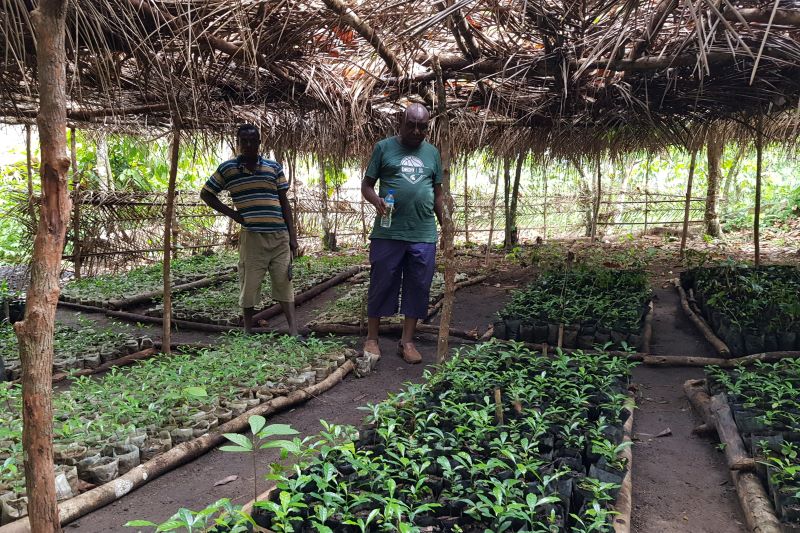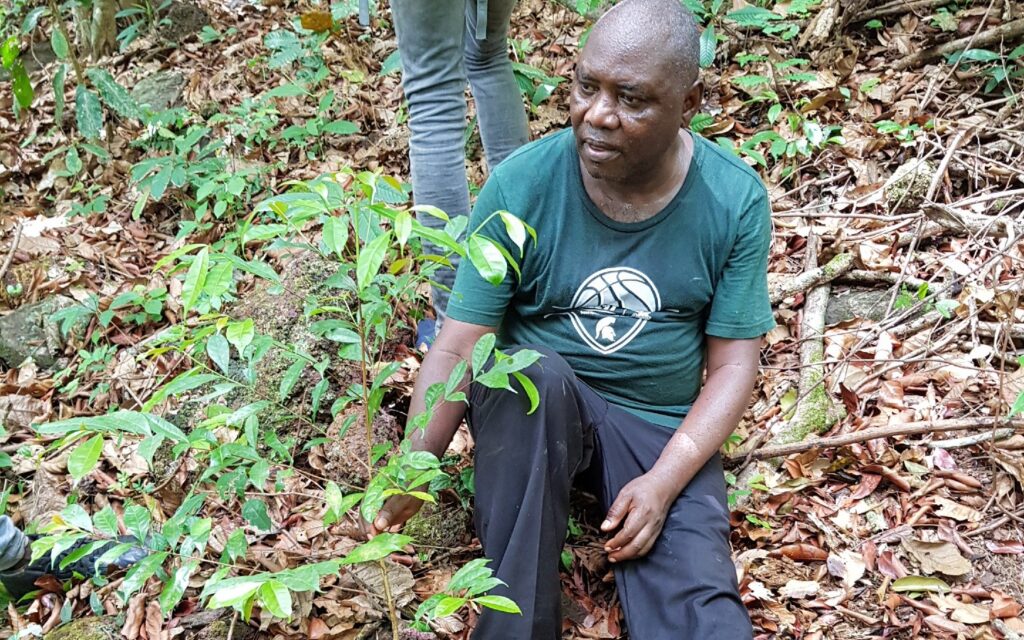Global coffee drinkers must welcome the news that Sierra Leone has achieved significant progress with a project to re-cultivate a historic local species better adapted to higher temperatures than climate-vulnerable Arabica, the main source for commercial coffee. Lost from cultivation for more than half a century, stenophylla coffee, or Coffea stenophylla, its scientific name, has been grown successfully at a pilot project in the east of the country following its rediscovery in the wild. It took a five-year-long search by a Sierra Leonean forestry expert, a sort of botanical Indiana Jones, slogging mile after mile through dense West African bush armed with little more than a pressing of a dried stenophylla leaf dating from the 1950s, before the first wild examples were found.
But it is the recent progress made in nurseries and plantations close to where the trees were rediscovered that the giants of the world’s coffee market, projected to be worth USD 113 billion annually by 2030, are watching closely. With rising temperatures and changes in rainfall threatening to wipe out more than half current coffee production, developments in Sierra Leone offer hope for climate-resilient solutions for the world’s coffee drinkers. The pilot project is driving ambitious plans to establish stenophylla, as the flagship product of Sierra Leone’s agricultural sector, a remarkable turnaround for a species once sold as Sierra Leone highland coffee, but which had been quietly forgotten through history.
Much more work needs to be done to establish the commercial viability of stenophylla, but progress of the preliminary project, funded by the Switzerland-based coffee trader Sucafina, has been encouraging. The results are so positive that it is believed that everything is in place to potentially rejuvenate Stenophylla, a coffee that was once drunk in Paris and London, but has not been sold commercially for decades, Daniel Sarmu, the forestry expert, who found the lost plant and is running the pilot, said. The Sierra Leonean project has implications for the world’s coffee market, as it offers hope in the face of the dire threat that climate change poses to the two species – Arabica and robusta – which produce the beans that go into almost all of the 400 billion cups of coffee drunk each year.
Grown commercially in more than 50 nations in an industry that generates more than 25 million jobs, these two species have a weak spot: vulnerability to climate change. What stenophylla offers, which makes it stand out from the 129 other known species of coffee, is a double whammy of great taste and heat tolerance. In blind tastings, held since the rediscovery, experts scored stenophylla as highly for taste as some high-grade Arabicas, as well as offering distinctly novel flavours. Many other wild species of coffee have been tasted over the decades, but with disappointing results. Stenophylla’s taste quality, which saw it traded and drunk in the coffee salons of Europe in the late nineteenth century, makes it stand out as a potential equivalent to Arabica and robusta.
Naturally occurring in the eastern highlands of Sierra Leone, a vestigial stenophylla farming sector flourished briefly during British colonial rule until the turn of the twentieth century when it dwindled and was forgotten, as mass production of Arabica and robusta came to dominate the global market. There are even early colonial records of it being grown commercially on hilly farm-holdings close to the centre of what is now Freetown, the coastal capital of Sierra Leone. It is its adaptation to the environment of lowland, tropical Upper West Africa that makes stenophylla so unique. With old records of it occurring naturally in Guinea-Conakry, Sierra Leone and Ivory Coast, on slopes of hills ranging from 200 to 700 metres above sea level, Stenophylla has a tolerance for high temperatures, and perhaps even some drought tolerance.
Sarmu and his two British collaborators, Aaron Davis from The Royal Botanic Gardens at Kew and Jeremy Haggar from the University of Greenwich, point out that more research needs to be done on the unique characteristics of stenophylla. This includes analysis of the climate, terrain, soils and topography that favour its growth and, importantly, its yield in terms of amount of berries and the time taken for the plant to grow from a seed to productivity. “We are learning all the time”, Sarmu said an that “Historic literature only gives part of the picture so we need to build up a better understanding. But the work we are doing is encouraging with, for example, plants promising to yield fruits (and thus coffee beans) after three or four years rather than the seven or nine years suggested in some of the old references”.
The lifecycle of Arabica and robusta is three or four years from planting a seed to harvesting fruit mature enough to produce commercial coffee. Working with his British colleagues, who found references to Stenophylla in old books and journals, Sarmu led the field work. A forestry graduate with a degree from Sierra Leone’s Njala University, to begin with all he had to guide him were a few old photographs and a dried sample of a stenophylla leaf that had been archived at the National Herbarium, which is located at his alma mater.
Sarmu led search parties with his colleagues in the forested hills around Freetown, but found no remnants of the historic farms where stenophylla bloomed more than a century ago. The city is located on a mountainous peninsula and although the slopes, which used to be heavily forested urbanisation, has led to a significant amount of deforestation. After cross referencing maps with old records his search focused far from the city in areas that included the Kambui Hills in the Eastern Province of Sierra Leone, densely forested areas, which meant locating the remnant Stenophylla plants was like hunting a needle in a sweaty, humid haystack. While experts have other ways to identify stenophylla the layman might look for their long, thin, spear-tip shaped leaves and their distinctive black berries, different from the deep red berries of commercial coffee plants.

After a search that lasted five years and working with local villagers and foresters, Sarmu eventually found 15 stenophylla trees and was able to gather fruits and so-called ‘wildlings’, young stenophylla plants propagated naturally in the wild. His work led to growing sense of ‘stenophylla fever’ as word spread among rural communities with foresters, farmers and hunters all searching for areas where the plant might grow. Stands of mature stenophylla have now been found in three areas in the east and south of Sierra Leone with more discoveries expected in other hilly regions. A five-acre plot was offered up by one community for a nursery, where seeds were successfully planted and germinated, appearing as seedlings under the cover of thatched sunshades made from palm fronds.
More than 1,400 seedlings cultivated in the nursery have been planted out in the areas where the project managers hope they will be able to mature and grow a first crop of fruit. Another 6,000 seedlings from the nursery are due to be planted out in the rainy season, which has just begun in Sierra Leone and will last until early September. The community is fully committed to the project and had made available 50 acres of additional land to be used as potential hub plantations for a more ambitious plan to grow stenophylla on a commercial scale. The first ones planted out are doing better than we expected, growing well, with good leaf development. “We were worried, it might take many years to crop, but now we think it will be about the time of commercial coffee plants”, Sarmu said.
Grafting experiments have also started with the top half of stenophylla plants grafted successfully onto rootstocks of Liberian coffee, Coffea liberica, which grows well in the area, but produces a lower value berry. More grafting work is planned to explore how best to develop commercial stenophylla production in an expedient and cost-effective manner. Potential stenophylla farming is the sort of commercial enterprise welcomed by the government of Sierra Leone, which has just opened a new ‘one stop shop’ for foreign investors seeking opportunities in the country. The newly-created National Investment Board, which streamlines a notoriously-clumsy current process for business licensing and regulation in Sierra Leone, is putting a strong emphasis on agriculture, the country’s single largest employer, and the environment. Stenophylla fits well with both categories of priority. Agronomists have studied the impact of rising temperatures and altered rainfall patterns on coffee production for Arabica and robusta. Most experts predict major problems with many accepting that if global temperatures rise at current levels, more than 50 per cent of the land where coffee is currently produced, would soon be unsuitable for production.

